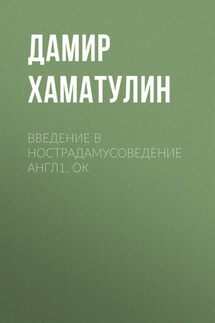Introduction to knowledge about Nostradamus - страница 4
If we talk about Nostradamus as a doctor who fought the plague with the help of miraculous drugs, then there are absolutely no facts about this either. On the contrary, the compositions described by him. from rose petals, for example, have nothing to do with anti-plague drugs.
So who is this man who became the Royal Physician and Astrologer, who already gained great fame during his lifetime? Now everything is much more detailed.
INTRODUCTION INTRODUCTION INTRODUCTION
As I already mentioned, the first work that has come down to us, written by Nostradamus, was written in 1541, or a little earlier. It came to us in the form of a manuscript of the Author himself, which is surprising and unique in itself, under the long title " ORVS APOLLO FILS DE OSIRIS ROY DE AEGYPTE NILIACQVE . DES NOTES HIEROGLYPHIQVES. LIVRES DEVX MIS EN INCREEDIBLE ET ADMIRABLE. ERVDITION ET ANTIQVITE . It is translated as follows: “Orus Apollo (Horapollon), son of Osiris, king of Egypt of the Nile (Nile). Hieroglyphic notes (records). Two books set out in rhythm (rhyme) by epigrams, a work of incredible and admirable erudition and antiquity. The manuscript consists of 86 sheets, and is a very free translation of the ancient Greek work.
Most likely, the primary source for the manuscript was, nevertheless, the already translated text of one of Nostradamus' contemporaries. Gorapollon's theme was relevant then. It is noteworthy that this manuscript is dedicated to Jeanne d'Albret, the young princess of Navarre, who at the time of its creation was (based on 1541) thirteen years old. According to the established practice, the authors of those years dedicated their works to well-known personalities who had already taken place, and here – to a girl, a girl.
The likelihood that she would ever become queen was very small. But it happened! In 1555 she became queen of Navarre.
The fact that the manuscript belongs to the pen of Nostradamus is a fact that has been researched and proven. As the name implies, this work consists of two parts, each part, in turn, consists of small notes-records, designated by the Author as " NOTE , NOTA , NOTHA , NOTHE ". In various ways, the time of the formation of standards for the grammar of writing was still far off.
Each NOTA gives an interpretation to an Egyptian hieroglyph. For example: “How did they designate eternity…” Further, in poetic form, the answer was given in several lines.
One of the notable features of the manuscript is its almost complete absence of punctuation marks, the absence of apostrophes (for example, lan instead of l' an ) and diacritics inherent in French writing. This is a rather important fact. The later published "Prophecies", especially the early ones, suffer, in part, from the same sores.
Now about Notre Dame's penchant for cryptography, revealed several years ago in this book by the remarkable French researcher Patrice Guinard. On the forty-second page of the manuscript, he discovered the first serious secret signature of the Author.
NOTENOTH
N ous demonstrer voulant le rauisseur
Ou roy tyran de son peuple ennemy
Seulement quayme flateurs et aportent
T enent ouuert lhuys comme a son amy
R ecord de ce ilz faisoient paingdre en my
A iant la gueulle ouuerte pres du ventre
D u crocodile et Trochillus qui entre
A tout son bec lui oustant les sangsues






